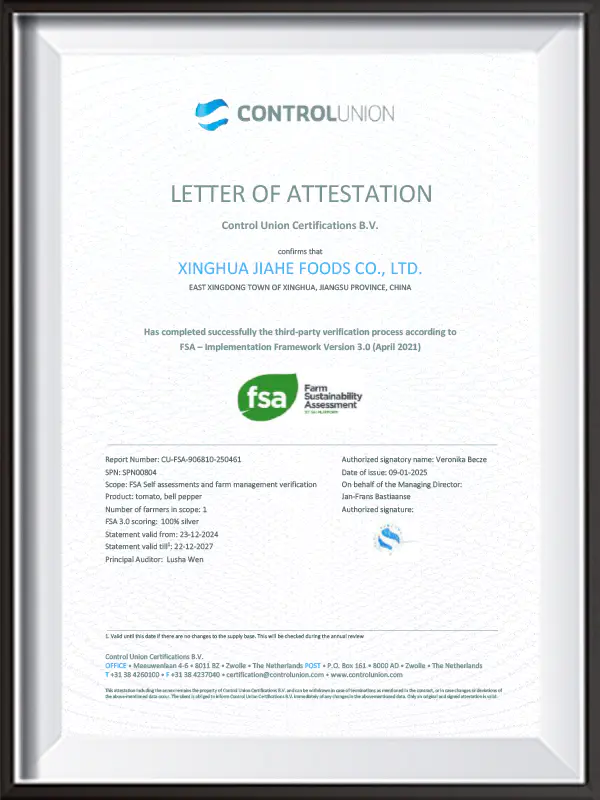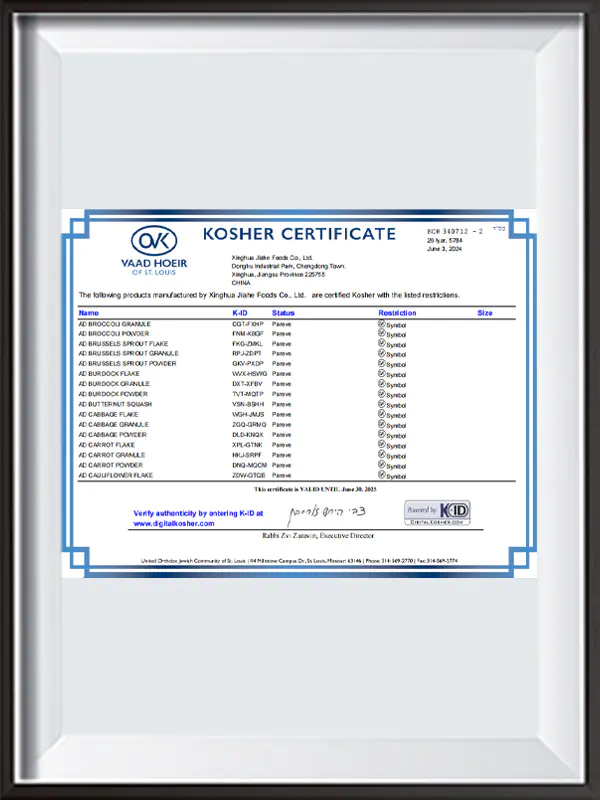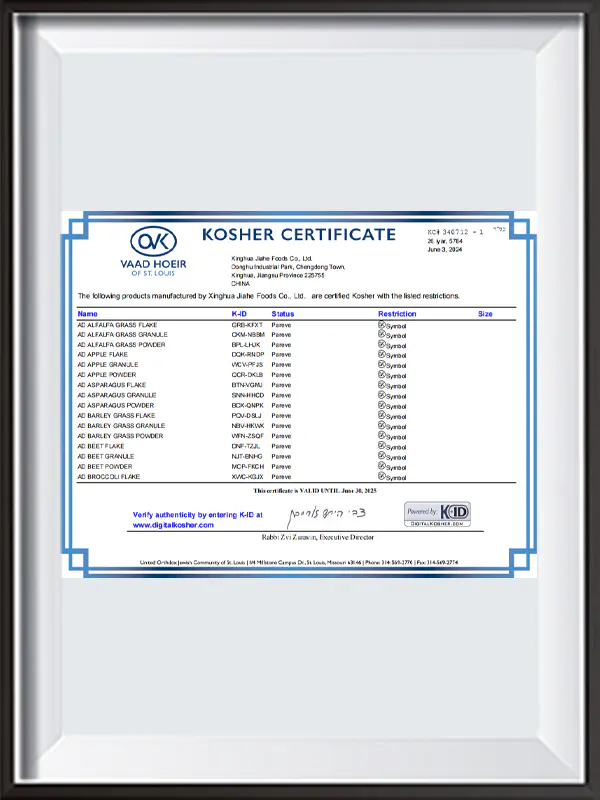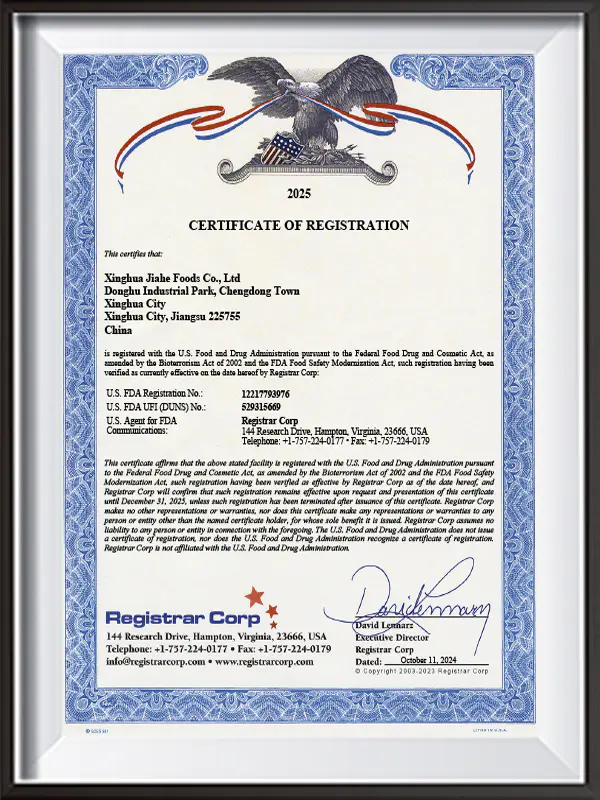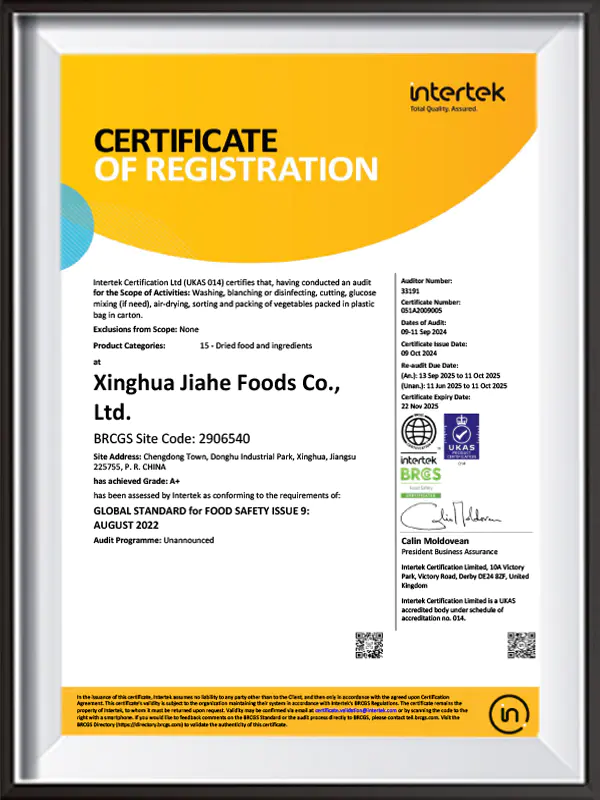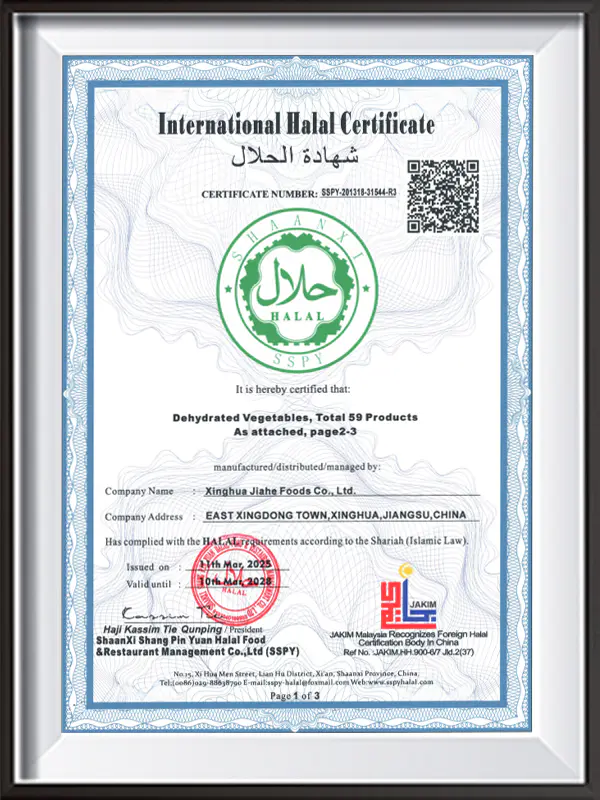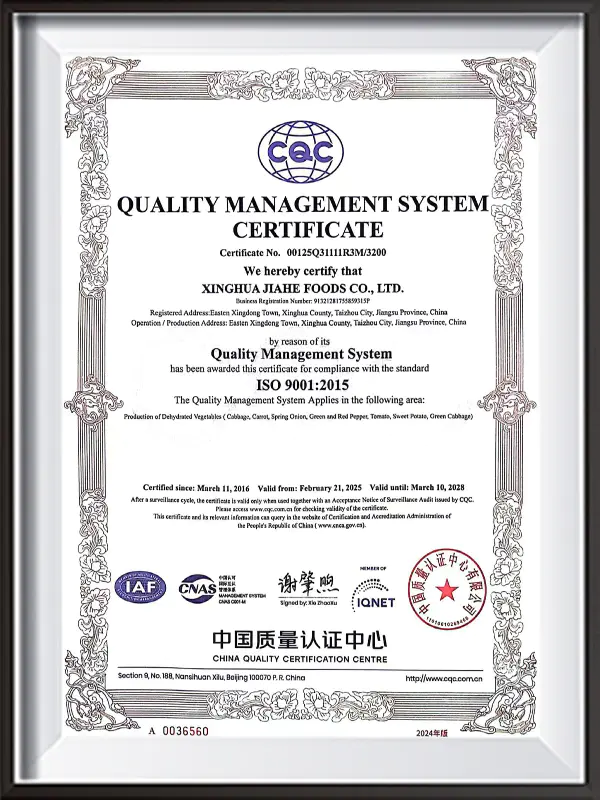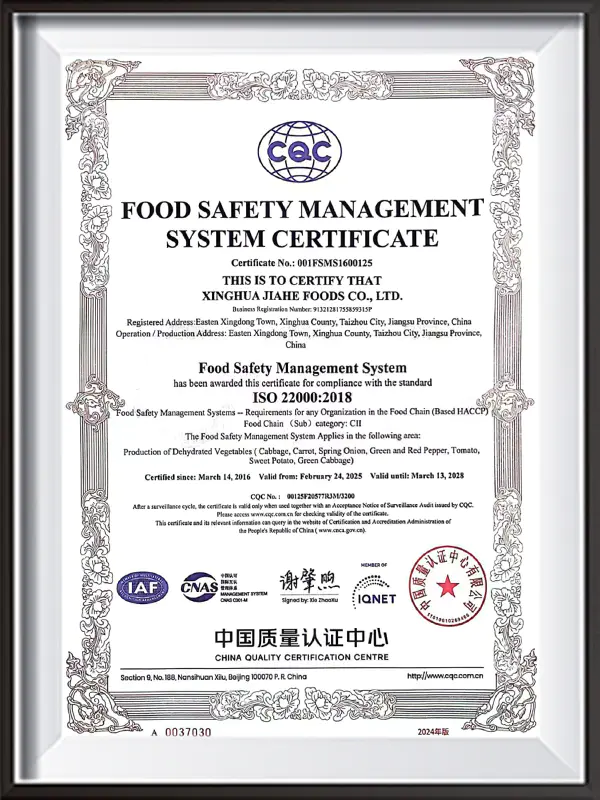Xinghua Jiahe Foods Co., Ltd is China Dehydrated Cabbage Manufacturers and Dehydrated Cabbage Factory, located in Xinghua city Jiangsu province, established in 2003. We are an experienced manufacturer and distributor of air dried vegetables and fruits in China. After more than 10 years fast development, now we are proud of being one of the top 3 manufacturers in China. We have built ourselves as a whole-range of consistent, affordable, and safe food products to the ingredient market. Our plant takes up an area of 25`000㎡with an annual capacity 8000 tons. We also have more than 300 hand-sorting workers, this is the last critical control point. Some defect materials which are out control of the facilities will be removed clearly. We have a multiple supply range. As Dehydrated Cabbage Exporter & Importer, we can supply you not only flake, dice, granules -- but also powder according to your need. All finish products are made from selected, fresh materials.
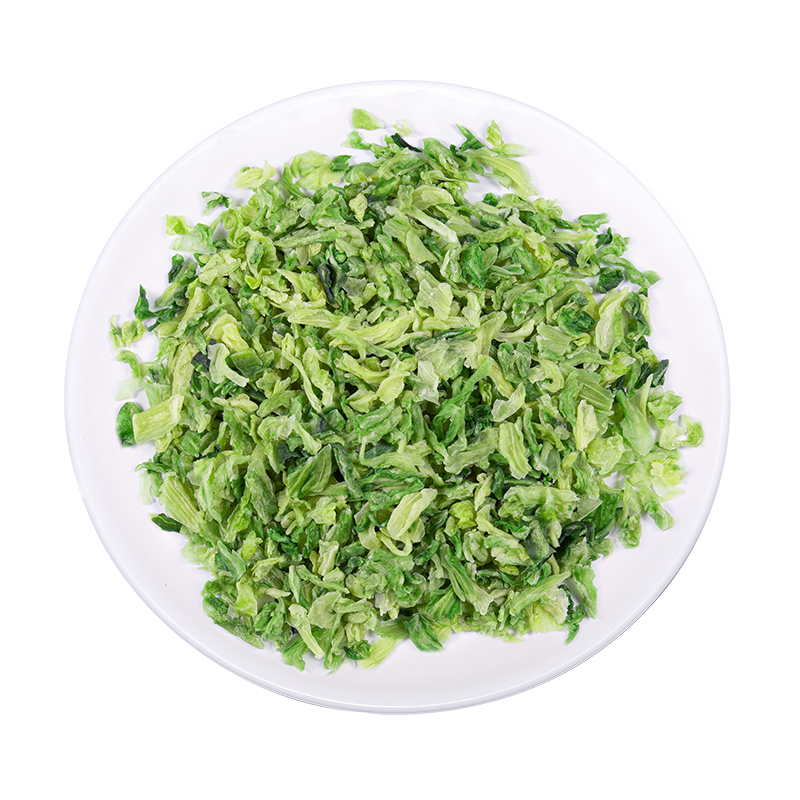
Dehydrated Cabbage
Field-fresh cabbage is sorted, washed, trimmed, blanched, and air-dried.The processing sequence initiates with rigorous cleaning protocols, material segregation, and HACCP compliance measures before proceeding to particle size modification via blade cutting or abrasive milling techniques.
- FLAKES
- GRANULES
- POWDER
- CUSTOM SIZE
Dried cabbage is used in a wide variety of applications including seasoning blends, salad dressings and salad products, sauces, soups and stews, pasta products, and ready meals.
Authentic reliable quality naturally stands out and fears no comparison.
Provide you with the latest enterprise and industry news.
-
How resistant is Dehydrated Carrot to caking or clumping under different environmental conditions?
Moisture Content, Water Activity (aw), and Hygroscopic Behavior The resistance of Dehydrated Carrot to caking is fundamentally driven by its moisture content and water activity (aw). Even though typical moisture levels range from 3–8%, Dehydrated Carrot remains mildly hygroscopic...
-
How does the moisture content of Dehydrated Sweet Potato affect its storage stability, rehydration capacity, and susceptibility to microbial growth?
Effect on Storage StabilityThe moisture content of Dehydrated Sweet Potato is one of the most critical factors determining its long-term storage stability. Low moisture levels, typically below 10–12%, reduce the water activity of the product, slowing down chemical reactions such ...
-
How does the Dehydrated Purple Sweet Potato contribute to a balanced diet, and what role can it play in supporting weight management or healthy eating habits?
1. Rich in Nutrients Dehydrated Purple Sweet Potato retains a significant portion of the nutritional value of fresh purple sweet potatoes. This makes it an excellent source of essential vitamins and minerals, particularly vitamin A, which is derived from beta-carotene. Vitamin A ...
What is dehydrated cabbage? Why dehydrate?
Dehydrated cabbage refers to a dish ingredient that uses a series of processes to remove water from fresh cabbage, and after drying, it retains its original nutrients, flavor and color. The dehydration process mainly uses physical means to quickly remove water from dishes using low or high temperatures to prevent the growth of microorganisms and chemical reactions, thereby extending its shelf life. Dehydrated cabbage can be used in ready-to-eat foods, quick-frozen foods, seasonings, soups and the catering industry. It is a highly convenient and long-shelf-life ingredient.
Dehydration technology is usually more effective than other preservation methods in preserving the flavor and nutrition of ingredients, avoiding problems such as vegetable deterioration and mold. Moreover, dehydrated products are small in size and light in weight, easy to store and transport, and suitable for all kinds of food processing plants and households. The market demand for dehydrated vegetable products, especially in the healthy diet and convenient catering industries, continues to grow.
Advantages of dehydrated cabbage:
Long-term preservation: Cabbage with most of its water removed is not easy to rot and can be stored for months or even years;
Lightweight and efficient: It greatly reduces transportation and storage costs, while being easy to use immediately and reducing cooking time;
Nutrient retention: The use of appropriate dehydration methods can maximize the preservation of minerals, vitamins and other nutrients in vegetables;
No need to add preservatives: The dehydration process has its own preservative effect, and no additional chemical preservatives are needed.
What is the production process of dehydrated cabbage?
The production process of dehydrated cabbage is a systematic process that involves everything from the picking of raw materials to the packaging and storage of the final product. The following are the main steps of the standard dehydrated cabbage production process:
Fresh cabbage is selected as the raw material. To ensure quality, each cabbage will be strictly screened to remove unqualified leaves and bad parts. After that, the raw materials will be washed to remove dirt, impurities and pesticide residues that may be attached to the surface.
The washed cabbage will be further sorted and classified by size and quality. The purpose of the operation at this time is not only to remove the parts that do not meet the standards, but also to ensure the uniformity of subsequent drying. All trimmed cabbages will be cut off the unnecessary outer leaves and hard core parts to ensure the quality of the final dehydrated product.
In order to maintain the color and nutrients of vegetables, dehydrated cabbage is usually blanched. Blanching can help destroy the activity of enzymes and prevent the color of dehydrated vegetables from turning yellow or changing in taste. In addition, blanching can effectively sterilize and improve the safety of products.
After blanching, the cabbage needs to be cut according to certain standards. Usually, blade cutting or grinding technology is used to cut the leaves into the required size. The cut vegetables can be adjusted according to needs. Common sizes include small particles, flakes, filaments, etc. Different particle sizes are suitable for different market needs.
Air drying is one of the core processes in the production of dehydrated cabbage. Common drying methods include hot air drying and low-temperature air drying. Air drying can remove moisture from vegetables by physical methods and maintain the original color and nutrients of vegetables. With the continuous advancement of drying technology, the drying equipment used in modern factories can control temperature and humidity more efficiently and ensure the stable drying effect of vegetables.
During the drying process, dehydrated cabbage needs to undergo multiple tests to ensure that the moisture content, color, taste and other aspects of the final product meet the standards. Products that pass the inspection will enter the final packaging stage, usually in vacuum packaging or bagging to ensure the hygiene and long-term storage of the product.
After the dehydrated cabbage is packaged, it will be stored in a low-humidity, cool environment. The dried cabbage is not affected by temperature and humidity, which is convenient for long-term storage. Finally, these products will be delivered to customers around the world through cold chain transportation or room temperature transportation.
Dehydrated cabbage market trends and future development
With the increasing demand of consumers for healthy diets and convenient foods, the dehydrated vegetable market is experiencing rapid growth. Especially in the fields of ** ready-to-eat foods, convenient catering, nutritional supplements, etc., dehydrated cabbage has broad application prospects. Here are a few market trends worth paying attention to:
As consumers become more aware of healthy eating, more people are beginning to pay attention to the consumption of organic and natural foods. Dehydrated cabbage, as a natural food with no additives, low fat, rich in fiber and vitamins, is in line with this trend. Many producers have begun to invest in the production of organic dehydrated vegetables to meet the market demand for high-quality green food.
Dehydrated cabbage is not only used in home cooking, but also plays an important role in the catering industry and food processing plants. With the increasing demand for fast food and ready-to-eat foods, dehydrated vegetables have gradually become a common raw material in these industries. In addition, dehydrated cabbage is also widely used in instant noodles, soups, seasoning packets and other products.
With the continuous advancement of technology, the production process of dehydrated cabbage has gradually developed towards automation and intelligence. From cleaning, cutting, drying to packaging, the use of intelligent equipment has greatly improved production efficiency and product quality. In the future, with the continuous application of technologies such as robotics, the Internet of Things, and big data, the production of dehydrated vegetables will be more efficient and precise.
With the strengthening of environmental protection policies and the improvement of consumers' environmental awareness, the dehydrated vegetable industry will pay more attention to sustainable development. From the cultivation of raw materials to energy consumption and wastewater treatment in the production process, environmental protection will become an important direction for the development of the industry. Many manufacturers have begun to take energy-saving and emission-reduction measures in their processes to reduce the negative impact on the environment.


 English
English Français
Français Español
Español
